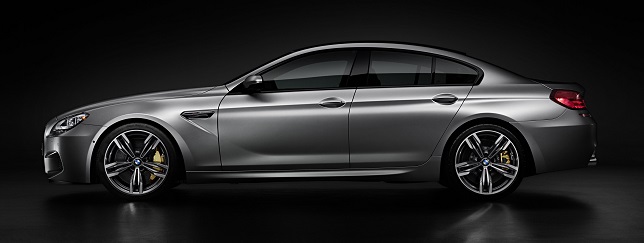

Sedan, 4 Doors, 5 Seats
9.9 l/100 km 23.76 US mpg
14 l/100 km 16.8 US mpg
7.6 l/100 km 30.95 US mpg
560 Hp @ 6000-7000 rpm.
127.4 Hp/l
250 km/h 155.34 mph
4395 cm3
268.2 cu. in.
8, V-engine
Rear wheel drive,
5011 mm
197.28 in.
1899 mm
74.76 in.
1875 kg
4133.67 lbs.
| Brand | BMW |
|---|---|
| Model | M6 (Sedan) |
| Version | M6 Gran Coupe (F06M) |
| Engine version | 4.4 V8 (560 Hp) |
| Year production start | 2012 |
| Year production end | 2014 |
| Vehicle type | Sedan |
| Horsepower RPM | 560 Hp @ 6000-7000 rpm. |
| Acceleration 0 - 100 kmh sec | 4.2 sec |
| Curb weight kg -lbs total |
1875 kg4133.67 lbs. |
| Overall length mm - inch |
5011 mm197.28 in. |
| Doors | 4 |
| Top Speed | 250 km/h 155.34 mph |
| Engine position and orientation | Front, Longitudinal |
|---|---|
| Cylinders | 8 |
| Position of cylinders | V-engine |
| Displacement (liters) |
4395 cm3268.2 cu. in. |
| Eng. horsepower RPM | 560 Hp @ 6000-7000 rpm. |
| Horsepower per litre | 127.4 Hp/l |
| Weight / horsepower kg/hp - hp/tons |
3.3 kg/Hp298.7 Hp/tonne |
| Weight / torque kg/Nm - Nm/tons | 2.8 kg/Nm, 362.7 Nm/tonne
2.8 kg/Nm362.7 Nm/tonne |
| Torque Nm RPM lb-ft RPM |
680 Nm @ 1500-5750 rpm.501.54 lb.-ft. @ 1500-5750 rpm. |
| Bore (mm in) |
89 mm3.5 in. |
| Stroke (mm in) |
88.3 mm3.48 in. |
| Compression ratio | 10 |
| Fuel delivery system | Direct injection |
| Fuel type | Petrol (Gasoline) |
| Valvetrain | 4 |
| Engine aspiration | Twin-Turbo, Intercooler |
| Engine oil liters | quarts |
8.4 l8.88 US qt | 7.39 UK qt |
| Engine coolant |
18.5 l19.55 US qt | 16.28 UK qt |
| Emission certification | Euro 5 |
| Powertrain architecture | Internal Combustion engine |
| Engine location | Front, Longitudinal |
| Drive configuration | Rear wheel drive |
|---|
| Front brakes | Ventilated discs |
|---|---|
| Rear brakes | Ventilated discs |
| Brake control | Ventilated discs |
| Anti-lock brake system | ABS (Anti-lock braking system) |
| Steering type | Steering rack and pinion |
|---|---|
| Turning diameter m - ft |
12.7 m41.67 ft. |
| Front suspension | Multi-link suspension |
|---|---|
| Rear suspension | Multi-link independent |
| Wheels size | 265/35 R20 102Y; 295/30 R20 104Y |
|---|---|
| Wheels rims | 9.5J x 20; 10.5J x 20 |
| Passengers seats | 5 |
|---|---|
| Trunk space min liter | cu. Ft. |
460 l16.24 cu. ft. |
| Overall length mm - inch |
5011 mm197.28 in. |
|---|---|
| Overall width mm -inch |
1899 mm74.76 in. |
| Overall height mm -inch |
1393 mm54.84 in. |
| Wheelbase mm - inch |
2964 mm116.69 in. |
| Track width front mm - inch |
1631 mm64.21 in. |
| Track width rear mm - inch |
1612 mm63.46 in. |
| Coefficient of drag | 0.33 |
| Curb weight kg -lbs total |
1875 kg4133.67 lbs. |
|---|---|
| Gross weight kg -lbs total |
2410 kg5313.14 lbs. |
| Capacities kg - lbs |
535 kg1179.47 lbs. |
| Fuel tank liters | gallons |
80 l21.13 US gal | 17.6 UK gal |
| City l/100km - mpg |
14 l/100 km16.8 US mpg |
|---|---|
| Highway l/100 km - mpg |
7.6 l/100 km30.95 US mpg |
| Combined l/100 km - Mpg |
9.9 l/100 km23.76 US mpg |
| Autonomy km (combined use) | 808 |
8 CYLINDER V-Engine
https://www.thecarspec.net/components/engine/8-cylinders-v